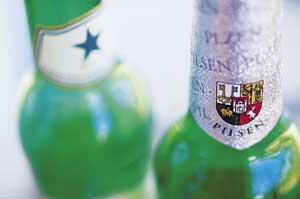
Think about a beer. Picture it in your mind’s eye. What do you see? If you’re like most people, you’re envisioning a silvery cold glass or mug of golden brew capped with a finger’s width or two of snow-white foam. The embodiment of refreshment. If that’s the portrait your imagination drew, you were probably thinking of a style of beer called pilsner. So it should come as no surprise that pilsner is the single most popular variety of brew in the world, counting everything from Budweiser to Corona to Kirin to Heineken among the inhabitants of its far-reaching family tree. But what you no doubt pictured isn’t what beer always looked like. In fact, for the vast majority of brewing history, the product of the ancient alchemy of grain, water and yeast was a dark, often murky liquid filled with flavors from fruits, nuts and some rather questionable ingredients probably best left unmentioned. In short, it was exactly like your first try at college homebrew. What we know today as the “typical” lager beer – the golden elixir you imagined – has been with us for only about a century-and-a-half. It was 1842 when a young Bavarian brewer named Josef Groll created the world’s first golden, hoppy lager in a small town located in what we now know as the Czech Republic (but which was then Bohemia). That town, which eventually lent its name to the beer style Groll pioneered, was Pilsen. As is the case with so many great innovations, the creation of pilsner was the product of a fortuitous union of ingredients and methods – in this case the pale barley malt, soft water and saaz hops of Bohemia combined with the unusually cool fermenting and conditioning methods developed in Bavarian breweries. The result, which apparently shocked the inexperienced and reportedly rather incompetent Groll as much as it delighted the citizenry of Pilsen, was a clear, golden and tantalizingly refreshing beer well-removed from the cloying and cloudy brews that preceded it. That beer lives still today in Pilsner Urquell, the original pilsner. Known among the beer cognoscenti as simply pilsner, Pilsner Urquell is the direct descendent of Groll’s surprising first brew. As all beers bearing the moniker pilsner should, it has a quenchingly dry character with light floral notes produced from its trademark saaz hops – a variety native to Bohemia but now grown from Germany to Idaho. And although production methods have been modernized dramatically since Groll’s day, the recipe for – and taste of – the beer have remained remarkably unaltered, providing interested beer consumers with a unique opportunity to taste a bit of history. While devotion to the purity of pilsner is evident in many, if not most, Czech lagers, the subtleties of the style do provide for an interesting variety of tastes. Reminding us that Bohemian pilsner doesn’t end at Urquell are the vigorous dryness of the Radagast Premium, a brand which, along with Pilsner Urquell, is now owned by South African Breweries, the softer, lightly sweet Krusovice, and the stunning complexity of Budweiser Budvar, which owing to its titular ressemblance to a certain domestic brew seems unlikely to ever be seen in North America. Unsurprisingly, the pilsner style flowed over Bohemia’s borders, too, and with Eastern Europe now opening up to exports, beer drinkers are discovering that many of that region’s breweries offer faithful and frequently impressive interpretations of the style. In particular, Poland has proven fertile ground for pilsner brewing, with breweries like Zywiec making good use of the plentiful soft, Pilsen-like water of the Skrzyczne Mountain in production of its gently hopped Zywiec beer. Also from Poland comes the even softer, delicately appetizing flavor of EB Special, as well as the medium-bodied Okocim beer. Of course, there are a few fine and faithful pilsners brewed on the home front as well. Beers like the Prima Pils, from Victory Brewing of Downington, Pennsylvania; Full Sail Pilsner, from Hood River, Oregon; and Davis, California’s Sudwerk Pilsner, provide tasty reminders that the craft-beer renaissance didn’t begin and end with hoppy ales. And it all stemmed from one Bohemian town’s need for a new brewer, one young Bavarian’s idea for a beer and the marvelously unpredictable hand of fate. Brewing history, indeed!  When I took my first sip of fresh Pilsner Urquell, I immediately knew what all the fuss was about. Where the bottled beer I’d tasted through the years had always been good, even great, the fresh draught beer that crossed my lips that day was simply extraordinary. And so I discovered the secret to great pilsner. As much as bottom-fermented lagers are distinguished from their top-fermented ale kin by their need of extra conditioning time (lager comes from the German word meaning “to store”) once these beers are ready, they’re best enjoyed as early as possible. The old chestnut, “beer is best when drunk at the brewery gate,” is very much applicable when it comes to a good pilsner. Since my Pilsner epiphany, I’ve repeated my freshness experience with several other very fine, pilsner-style lagers, including the malty Creemore Springs Lager from Ontario, Canada (sampled in the brewery board room); the tasty Freedom Lager of London (tasted on the brewery floor); and the classic Budweiser Budvar (downed at the brewery beer hall in Prague – miles from Budweis, but spectacularly fresh nonetheless). Each and every time, the beer’s remarkable freshness and flavor has prompted me to silently thank the car, plane or train that brought me to the glass of lager in my hand |




